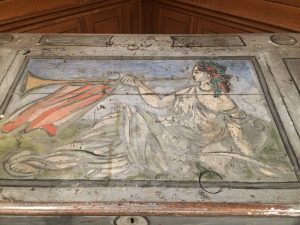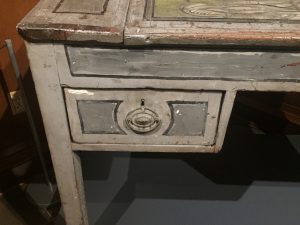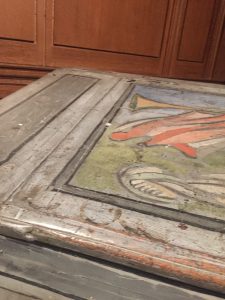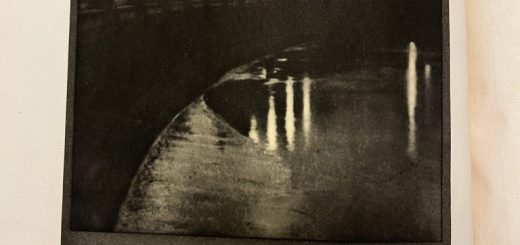Virginia Woolf’s Writing Desk by Carly M.
I was initially drawn to the idea of studying Virginia Woolf’s writing desk primarily because I was surprised that Duke had it. I am not much of a reader in any sense of the word, but even I recognize her name and know that her work as earned a place in the literary canon.

The desk itself was different than I had envisioned it. In my mind, I saw a desk made of dark wood with ornate carvings, delicately preserved and with few signs of life. The low oak desk in front of me, however, was coated in a pale, greenish-gray paint. The muse of history, Cleo, is painted on the sloped top, with other details that one might typically find etched into the wood instead also painted on. The only distinct features aside from the paint are two small drawers underneath the desk. The entire thing is covered in splatters of dark paint, rings from the bottoms of cups, and other various stains.


Immediately, I found the condition of it very peculiar. Why would she paint at her writing desk? Given my own personal tendency to get permanent paint on everything within a five-foot radius of my work station, painting near (or on) anything I care about is the last thing I want to do.
As it would turn out, the desk at it currently exists is not at all how it looked when Woolf used it. The then-teenaged Woolf commissioned it as a standing desk in the 1890s. She used it for over thirty years, and it is likely where she would have written “The Mark on the Wall” (1917), “A Haunted House” (1921), Mrs Dalloway (1925), and “The Lady in the Looking Glass” (1929). However, Woolf gifted the writing desk to her nephew in 1929, who was a painter named Quentin Bell. The painting of the muse and all the splatters and stains covering her were Bell’s handiwork, not Woolf’s. His wife, Anne Oliver Bell, also cut six inches off of the legs of the desk to make it a sitting desk.
While it is not possible to determine how it looked when it was commissioned, or its condition after Woolf’s use, I am still able to glean a few assumptions about Woolf from studying it. Given that she seems to have commissioned it before she started writing professionally and that it was a standing desk, I can only imagine that it was important to her to have a space dedicated exclusively to writing even before it became her career. The benefits of using a standing desk as opposed to a traditional one, which many modern workers are only just beginning to explore, suggest a heightened level of insight on her part regarding either her physical health or her productivity, which I found rather impressive. This level of introspection and personal awareness should not be surprising, coming from the queen of stream-of-consciousness herself. The fact that she used it for over thirty years before gifting it to a family member also suggests to me both a sense of routine and attachment.
There is a bit of irony in that the full history of the desk has been lost to the muse of history. We are left to only imagine what lies underneath the paint splatters and water stains. At this stage, it remains more Quentin Bell’s Painting Desk than anything else. It is not entirely inaccurate to continue calling it Woolf’s desk. She had been the one to commission it and first use it, after all. It certainly makes sense from the standpoint of a museum curator to keep the title, as Woolf is much more famous than her nephew. Outside of very specific circles which I only imagine exist, the name Quentin Bell is unlikely to draw much of a crowd. However, calling it her desk promises us a history we cannot see. The thirty years of labor worked into its surface are now invisible to us.









What a wonder wood art! I love it and I am very fond of it. Chairs, tables … all kinds of furniture to restore is an art! Thanks friend!